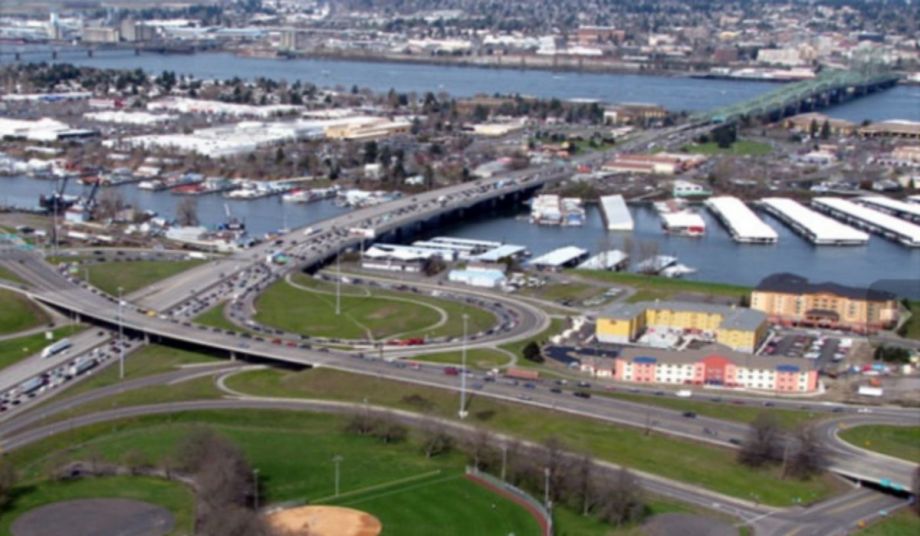I know why folks in Vancouver, Wash. don’t want Portland to succeed in extending its light rail system across the Columbia River and into their town. If that happens, it’s just a matter of time before Carrie Brownstein starts hanging out in their coffee shops and their bartenders will have to start stocking organic beer. I get it. I don’t like Portlandia either.
The current Columbia River Crossing (CRC) along Interstate 5 was first built in 1917 and expanded in 1958. It sees about 128,000 daily trips and one daily car accident. While a coalition has been working since 2005 to build a new bridge across the river, the idea gained momentum when another of the interstate’s spans collapsed on May 23. (The incident yielded no deaths or serious injuries.)
A quick look at the map reveals that, like too many interstates, I-5 rams right through the center of the 28th largest city in the U.S. While that’s too bad, there are a number of other aspects of the CRC rebuilding plan that should appeal to those who appreciate good urban policy.
- A light rail extension to Vancouver’s Clark College. While we learned from Jeff Speck’s Walkable City not to automatically support all transit projects, this one seems to meet his test by connecting fairly dense, walkable areas to other fairly dense, walkable areas.
- User fees. The largest single source of funds for the project — approximately $1.3 billion — will come from tolling. There’s a bit of a game of who’s-got-more-consultants going on right now over how reasonable the revenue estimations are, but generally speaking it’s always a good sign when infrastructure’s users pay for it.
- Smart tolling. The tolls on the bridge will vary with volume, allowing the system to lower user fees during lighter traffic and increase it when it’s heavier, thereby creating an incentive for drivers who don’t need to cross at the busiest times to wait.
- Bike and pedestrian crossing. The current bridge has a four-foot-wide path alongside auto traffic for non-drivers. Too small for cyclists to pass pedestrians. Too close to cars for anyone to hear themselves think. The new bridge will create a large path on a span below the cars (which doesn’t sound great, but it’s better).
Light rail and tolls seem to be at the heart of much of the public’s opposition to rebuilding the CRC. Vancouver is home to the Nautilus Corporation’s headquarters, but functions largely as a bedroom community for folks working in Portland. Objections on the Washington side have had unseemly moments, and while the State of Oregon has done what it needs to do to move the bridge project forward, the CRC coalition has yet to secure the necessary approvals from the State of Washington and, critically, the Coast Guard, who closed public comments on Thursday.
A major issue for the Coast Guard to consider is whether or not limitations on freight traffic on the waterway are reasonable. Three major local manufacturers have said that they would be unable to get their new, larger projects under a much lower bridge. Two of the three manufacturers, however, have come to support the deal under undisclosed terms.
In Washington, D.C., lawmakers are fighting over $850 million in federal funds that hinge on the light rail expansion. The Congresswoman who represents Vancouver has proposed a transportation budget bill with only enough money to fund 17 other projects ahead of the CRC, leaving no funds left over in case its supporters are able to meet the regulatory requirements to win federal money in the 2014 fiscal year. The House has not yet voted on her proposal.
Meanwhile, Sen. Patty Murray, also of Washington State and chair of the Committee on Transportation’s Appropriations Subcommittee, has predicted that when the project is approved even its opponents will be there to stand with her at the ribbon cutting. The Senate is working on its own transportation funding bill now.
If supporters are right, however, and a new bridge that supports new modes of transit spurs greater economic development, that might not be the best news for all of Portland. As we discussed earlier, I-5 runs right through the city. If auto traffic across the bridge increases, as proponents expect, that will naturally increase political pressure to widen the interstate in the heart of city and displace neighborhoods.
When the two states originally built the first crossing between the cities, things got so divisive that legislators barely managed to write a deal before the session closed in 1911. Determined to have the governor see it, proponents attempted to deliver the legislation to his house. His wife kicked it out the door.
However, the opposing lawmakers struck a deal the next day, and the bridge went into operation six years later. In fact, the original bridge included a streetcar that shared the road with other users. So if the coalition pushing the CRC succeeds, the two cities will once again be united by rail. Only under the new design, transit won’t have to stop moving every time there’s an automobile accident. Isn’t it strange that giving folks more ways to come together is always so divisive?
Correction: A previous version of this story erroneously reported that one of the attractions to living in Vancouver, Wash. is avoiding Oregon income taxes. This was incorrect. Those who work in Oregon pay the income tax. Multnomah County, where Portland resides, also had an income tax for a few years (2003-2006).
Brady Dale is a writer and comedian based in Brooklyn. His reporting on technology appears regularly on Fortune and Technical.ly Brooklyn.
















